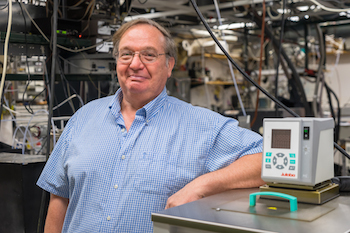A .gov website belongs to an official government organization in the United States.
A lock () or https:// means you've safely connected to the .gov website. Share sensitive information only on official, secure websites.
6 April 2018

Dr. James Burkholder receives a 2018 NOAA Distinguished Career Award for Professional Achievement, "for sustained contributions in conducting laboratory studies of atmospheric chemical processes at the atomic and molecular level and interpreting them to provide fundamental information about how human activities influence important societal issues such as stratospheric ozone depletion, climate change, and air quality." Jim is highly deserving of this award for his many years of laboratory studies and leadership.
The Distinguished Career award is given to those who have contributed a significant body of professional work and who have helped achieve NOAA's mission over the course of their careers. Rather than honoring just a single accomplishment, this award recognizes those who have continued to meet and exceed expectations in their field during their tenure at NOAA.
Jim was nominated for his scientific and professional achievements at NOAA over the past 35 years. He began as a post-doctoral student in the atmospheric chemical-kinetics laboratory in the early NOAA Aeronomy Laboratory, where he has now conducted hundreds of laboratory experiments to elucidate and quantify the fundamental mechanisms by which atmospheric species participate in atomic and molecular reactions and interact with visible and infrared radiation. He has grown to lead atmospheric laboratory studies in NOAA and to have few peers worldwide that share a similar stature and portfolio of scientific accomplishments.
Jim Burkholder has been involved in research aimed at understanding and managing the threat of stratospheric ozone depletion due to chlorofluorocarbons (CFCs), which has been a notable achievement in the Atmospheric Chemistry community. The description of fundamental reactions of chlorine-containing chemical species forms the basis of the policies agreed upon during the Montreal Protocol. Jim continues to lead studies that characterize stratospheric chlorine chemistry and asses CFC replacement compounds for their ozone depletion potential (ODP) and global warming potential (GWP).
Jim has also been at the forefront of technological advancement in his area of study. He has led effort to update a key database of atmospheric chemical kinetic information by transforming the database into an online, interactive resource; this is just one of the ways his efforts contribute to scientific achievement in CSD and NOAA. Jim has also worked towards greater transparency and access while collaborating with other agencies and organizations. He led the effort to make the NASA JPL Chemical Kinetics and Photochemical Data Evaluation Panel a web-based, updated system that can be accessed by the community and revised by authorized experts. This database is designed to be as useful as possible, and will continue to aid researchers and scientists.
Jim's ability to lead and his commitment to improving research in atmospheric chemistry is apparent from his efforts to observe what other scientists in his field have done and take a new approach to problems. For example, two prior laboratory studies were designed to resolve a controversy over the photolysis rate of the chlorine monoxide dimer (ClO)2, a compound that is a key rate-limiting step in catalytic ozone destruction. One study found a markedly different rate than what was measured by the first study in the series, calling into question the validity of our understanding of ozone loss kinetics. In response, Jim initiated a rapid-response effort to re-measure this key process so that the community could rebuild its confidence in the results and subsequent numerical modeling. The endeavor was highly successful, and helped resolve tensions between the apparent differentiation.
Jim receives this well-deserved recognition at the award ceremony on May 22 at NOAA Headquarters in Silver Spring, Maryland.